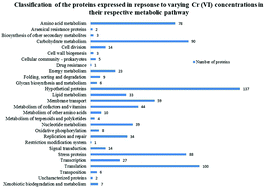Proteomic response of marine-derived Staphylococcus cohnii #NIOSBK35 to varying Cr(vi) concentrations†
Abstract
Chromium in its hexavalent state is a water-soluble and toxic element to living organisms present in the environment. However, some organisms are resistant and reduce the toxic forms of Cr(VI) to less toxic or non-toxic forms. A global proteomic analysis of Staphylococcus sp. #NIOSBK35 under different chromate concentrations (0, 100, 200 and 300 mg L−1) at different time points in its growth stages (6, 9, 12, 18, 24 and 36 h) resulted in the identification of 878 proteins. Of all the proteins expressed, 13 proteins [23 rDNA (uracil-5-) methyltransferase RumA, multidrug ABC transporter ATP binding protein, dihydroxy acid dehydratase, polysaccharide biosynthesis protein, etc.] were expressed only in the presence of chromium. 14 proteins were up-regulated in response to chromium(VI), namely, alkyl hydroperoxide reductase, ATP-dependent Zn metallopeptidase, hsp90- like protein, NAD (P)-dependent oxidoreductase, etc. Most of the proteins involved in normal cell functioning like 1-pyrroline-5-carboxylate dehydrogenase, ribosomal proteins (30S ribosomal protein S11, 30S ribosomal protein S2, and 50S ribosomal protein L32), aconitate hydratase, DNA primase, serine-tRNA ligase, phosphoenolpyruvate-protein phosphotransferase, enolase, sulfur transferase FdhD, etc. were found to be down-regulated. On grouping these proteins into their COG (cluster of orthologous groups) functional categories, they were found to be involved in translation, carbohydrate metabolism, stress proteins, amino acid transport and membrane transport mechanisms. The proteomic response given by Staphylococcus sp. #NIOSBK35 did not show expression of Cr-specific proteins, indicating a different mechanism of Cr-tolerance as the organism was able to survive and grow at high concentrations of Cr(VI).



 Please wait while we load your content...
Please wait while we load your content...